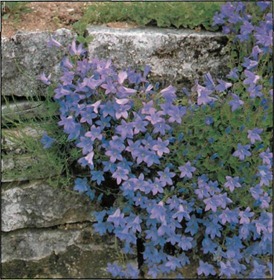





Plants which tolerate dry, and often poor, conditions are ideal for growing in walls. They need little attention, give a reliable, colourful display and bring a sparkle to the nooks and crannies of an otherwise bare site.
There is a mass of beautiful plants which will thrive in a dry stone wall. It is safest to choose varieties which prefer, or at least tolerate, dry conditions.
A dry stone wall is the ideal site for drought-resistant plants. Their shallow, wiry roots successfully penetrate the small areas of soil. Such plants do not grow very large and will not damage the wall’s structure.
Each plant still needs some soil for the roots to grow into. This is for it to take up nutrients and water, and for support.
 Plants can grow on the top or sides of a wall. They do not have to be on a flat upper surface. Choose a plant’s final position according to whether it needs sun or shade. You should be able to find both at different points of the wall, so take advantage of all its aspects.
Plants can grow on the top or sides of a wall. They do not have to be on a flat upper surface. Choose a plant’s final position according to whether it needs sun or shade. You should be able to find both at different points of the wall, so take advantage of all its aspects.
Shade-lovers prefer a north-facing side; plants which prefer to be baked by the sun in a sheltered spot suit a south- or west-facing side. Plants which can withstand an open, exposed site are ideal for the top of the wall. Some, such as candytuft, are adaptable to all these different conditions and have no preference as to aspect.
The best time to fill a dry stone wall with plants is when constructing it, so that roots are bedded into the soil behind. If this is not possible, there are two ways of establishing plants on an existing wall.
To grow plants from seed, find suitable cracks and crevices which have some loose soil. When the seeds germinate, the seedlings can establish themselves in the soil. Keep the site moist.
Correct watering is vital at this critical stage of development. If seeds are too dry, they will not germinate that year.
Usually in spring there is enough rain for good germination, but if none appears for several days after you have sown the seed, water frequently until it does rain.
BUYING TIP
When first planting a dry stone wall it is a good idea to go to a specialist alpine or rock-garden centre so that you can be sure the plants suit the chosen location. For planting in later years, try seeds, which are an inexpensive way of trying out unusual varieties.
Buying seedlings or making transplants from other parts of the garden is the best means of filling the dry stone wall with immediate colour.
Plants should be small and young so they can adapt to their new site. They will probably have come from richer, damper soil, whether they are container grown or transplanted. Do not try to use plants which are fully mature and have reached their maximum size. They may not survive the shock of moving to a stressful and harsh environment.
• Find a suitable gap between the wall stones or bricks which has enough room for the plant’s roots to grow into. There should also be enough space to add some more soil to cover up the roots completely. This gives them the best possible start.
• Use a sandy mixture with loam (crumbly garden soil rich in organic matter).
• Push the roots well back into the recess of the crevice. Try not to damage them if at all possible.
• Transplant in autumn or spring, when there is plenty of rain. Do not transplant in very dry weather.
• Water plants if drought threatens during their first few months.
TIP
PATHS AND PATIOS
Wall plants usually grow well between paving stones and blocks on paths and patios. They soften the look of the stone and make it seem cooler in the heat. As the gaps are often small, plant seed directly into the cracks. The roots need to be in touch with the soil, which may mean breaking underlying foundations. Water often, until the seedlings are well established.
Copyright © www.100flowers.win Botanic Garden All Rights Reserved